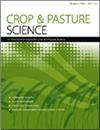Performance of young endophyte-free and endophyte-infected tall fescue (Festuca arundinacea) plants under partial and total submergence
IF 1.9
4区 农林科学
Q2 AGRICULTURE, MULTIDISCIPLINARY
引用次数: 0
Abstract
Context Tall fescue (Festuca arundinacea Schreb.) is a valuable temperate forage grass. Tall fescue plants associated with Epichloë fungal endophytes are successfully spreading in grassland regions that are recurrently exposed to flooding.Aims We asked whether the association with fungal endophytes increases plant performance under water excess.Methods In a greenhouse experiment, we evaluated the differential performance of young endophyte-infected and endophyte-free tall fescue plants in response to 14days of partial and total submergence. We included a wild local population and a cultivar, each with their respective fungal endophyte: the common endophyte and a safe (non-toxic) endophyte (AR584).Key results Relative to control (non-submerged) plants, and regardless of endophyte status, total submergence resulted in a significant growth reduction. At the end of the partial submergence period, the number of leaves per plant increased (21%) in the presence of the safe endophyte AR584 but decreased (18%) in the presence of the wild endophyte. Moreover, under partial submergence, the presence of wild endophyte decreased pseudostem dry weight by 10%.Conclusions Our results show that the presence of either the wild or the safe endophyte did not increase the performance of young tall fescue plants under submergence conditions.Implications Although all endophyte-free and endophyte-infected tall fescue plants survived submergence treatments, we cannot rule out that Epichloë endophytes might improve plant fitness under longer stressful submergence conditions. Future research should explore how endophytes modulate host performance under water excess, considering different phenological plant phases and/or co-occurrence with other stress factors (e.g. high temperatures).部分浸没和完全浸没条件下无内生菌和感染内生菌的高羊茅幼株的生长性能
高羊茅(Festuca arundinacea Schreb.)是一种珍贵的温带牧草。与Epichloë真菌内生菌相关的高大羊茅植物在经常遭受洪水侵袭的草原地区成功地传播。目的:我们想知道在水分过剩的情况下,真菌内生菌是否会增加植物的生长性能。方法在温室试验中,研究了受内生菌侵染和未受内生菌侵染的高羊茅幼苗在14d部分浸没和完全浸没条件下的不同表现。我们纳入了一个野生当地种群和一个栽培种群,每个种群都有各自的真菌内生菌:普通内生菌和安全(无毒)内生菌(AR584)。与对照(未淹水)植株相比,无论内生菌状态如何,完全淹水均导致植株生长显著降低。在部分淹没期结束时,安全内生菌AR584的存在使单株叶片数增加(21%),而野生内生菌的存在使单株叶片数减少(18%)。此外,在部分淹没条件下,野生内生菌的存在使假茎干重降低了10%。结论无论是野生内生菌还是安全内生菌的存在,均不能提高高羊茅幼苗在淹水条件下的生长性能。尽管所有无内生菌和感染内生菌的高羊茅都能在淹水处理中存活下来,但我们不能排除Epichloë内生菌可能提高植物在长时间胁迫条件下的适应性。未来的研究应考虑到植物不同物候阶段和/或与其他胁迫因素(如高温)共同发生,探索在水分过剩条件下内生菌如何调节寄主的性能。
本文章由计算机程序翻译,如有差异,请以英文原文为准。
求助全文
约1分钟内获得全文
求助全文
来源期刊

Crop & Pasture Science
AGRICULTURE, MULTIDISCIPLINARY-
CiteScore
4.20
自引率
15.80%
发文量
111
审稿时长
3 months
期刊介绍:
Crop and Pasture Science (formerly known as Australian Journal of Agricultural Research) is an international journal publishing outcomes of strategic research in crop and pasture sciences and the sustainability of farming systems. The primary focus is broad-scale cereals, grain legumes, oilseeds and pastures. Articles are encouraged that advance understanding in plant-based agricultural systems through the use of well-defined and original aims designed to test a hypothesis, innovative and rigorous experimental design, and strong interpretation. The journal embraces experimental approaches from molecular level to whole systems, and the research must present novel findings and progress the science of agriculture.
Crop and Pasture Science is read by agricultural scientists and plant biologists, industry, administrators, policy-makers, and others with an interest in the challenges and opportunities facing world agricultural production.
Crop and Pasture Science is published with the endorsement of the Commonwealth Scientific and Industrial Research Organisation (CSIRO) and the Australian Academy of Science.
 求助内容:
求助内容: 应助结果提醒方式:
应助结果提醒方式:


